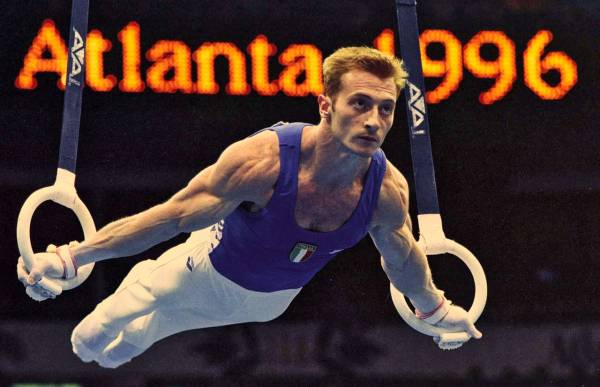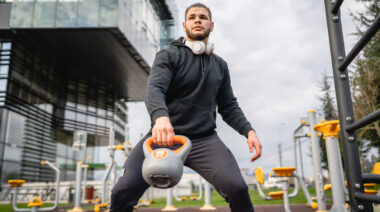You can get caught up kettlebells to the point of distraction. Enthusiasts can become almost territorial about their use and efficacy to the point of being cultish. There are whole organizations devoted to telling you their way is the only way to use kettlebells and, frankly, the nuances are lost on all but the devoted. Ultimately, kettlebells are a tool so, what are the best ways to integrate them into your training and workouts?
Giulio Palau – The Development of Active Flexibility
A kettlebell is an excellent tool for developing dynamic stability of the shoulder complex, particularly in the overhead position. When positioned optimally on the wrist and forearm, the load is balanced directly over the shoulder joint, allowing for greater variability of movement, which allows you to train shoulder stability in a myriad of different positions.
The progression of isometric holds in the armbar and Turkish get up variations allow for the development of what I like to call “active flexibility”. Instead of passively stretching tissues to achieve greater range of motion, challenging the joint to stabilize properly under load can improve range of motion while simultaneously building strength and control in new positions.
The armbar is an effective way to develop active flexibility in extension of the shoulder, a position that is typically neglected by the anterior orientation of most lifestyles. The armbar is also effective in teaching how to generating torque at the shoulder by creating a moment of external rotation and depression of the shoulder joint (both movements that are necessary to building stability overhead).
Once you’ve mastered the armbar, the Turkish get up will be the next natural progression. Get ups will teach you to stabilize the shoulder through an even greater range of movement and positions, with the added benefit of dynamically challenging the core musculature. Get ups will help to integrate shoulder stability in global movements and generate force upward by staying connected to the ground.
Naturally, the next progression will be the overhead press. The overhead press will challenge the shoulder through a full concentric and eccentric movement (as opposed to the isometric holds of the armbar and get up). The press also has the added benefit of teaching stability throughout the body in order to press overhead safely and efficiently. Although this progression can be extremely effective at building functional strength, the exercises described above require a baseline of training experience in order to perform safely.
Please be cautious and try to perform these exercises unloaded before using weight. One approach I use to build a functional understanding of these movements is to perform them while balancing a slider on your closed fist. This will create a safe challenge to practice proper joint positions and dynamic control before loading the exercise.
Ted Sloan – Kettlebells Are Great but Just One Tool
Kettlebells can be a great tool for assisting in the development of power. The stability and strength that kettlebells can help to create can contribute to a better performance in other similar movements important to the development of maximal strength; the barbell military press for example.
The complementary nature of such opposing exercises as the military press and the chin-up are such that when antagonistic muscle groups are unbalanced, the strength of the stronger muscle becomes limited by the neurological system and risk of injury in athletics increases.
When attempting to build maximum strength and subsequently maximum power in an athlete’s throwing and swinging mechanics, the overhead strength can be a limiting factor. The ability to perform overhead movements in a neutral position can appeal to some for the belief in it reducing the risk of injury or overuse with overhead athletes.
Some exercises that can be performed with kettlebells can be great tools in the development of power as well. With the necessity to develop equal strength in atomistic muscle groups, the need for power in this range of motion can be seen as well. The push press is a decent substitute for the clean. Although it doesn’t quite do the same job as the clean, it helps to develop explosive strength through the legs and to a small extent the arms.
Fighters often avoid the use of the military press due to a fear of it slowing down their striking speed and strength; this can potentially be attributed to the rather isolated nature of the exercise, in that the legs are not very involved. Due to this fact, the use of a push press can partially substitute.
The kettlebell snatch can assist with upper body power and stability as well, although more challenging to maintain a neutral catch position. Kettlebells are an amazing tool, but in the end, only one of the many that should be included in your tool chest.
Antonio Squillante – Developing Strength in a Position of Mechanical Disadvantage
Kettlebells are a very interesting tool. They provide what I like to call “a strategic overload”. Because of their size and because of the way kettlebells can be held, it is possible to perform movements with a greater degree of freedom but, even more importantly, with a greater degree of synergy between agonist and antagonist muscles during the the concentric and the eccentric phase of each exercise.
Because of a relative small component of horizontal displacement – a “negative” aspect normally associated with the use of traditional barbells that more often than not results in lack of mechanical efficiency – kettlebells allows for a combination of fast-concentric, low-eccentric unilateral muscle actions, a pivotal point when it comes to create stability around the major joints.
No other joint calls for an overall need for stability more than the shoulder joint. The gleno-humeral joint is one of the more “mobile”, yet strong, joints in the human body. When people think about “shoulder stability” they tend to forget, however, about “shoulder strength”, a complementary aspect that needs to be addressed in order to promote optimal shoulder mechanics.
I like to look at the picture below of Yuri Chechi, the Italian gymnast, holding a crucifix position at the 1996 Olympic Games in Atlanta, the year he won the gold medal at the rings: isn’t that a great example of shoulder stability?

Kettlebells are a great form of overload when it comes to overhead movements and their progression toward a perfect verticality overhead. Because of their characteristics, they force you to create stability around the gleno-humeral joint by articulating movements that require optimal centration of the humeral head in the glena , a mechanical feature that involves a perfect combination of eccentric and concentric muscle action involving the entire musculature of the shoulder girdle. At the same time, overhead presses performed with kettlebells foster the development of muscular strength in a position of mechanical disadvantage, increasing active range of motion under load, the stereotypical definition of mobility when it comes to functional strength.






